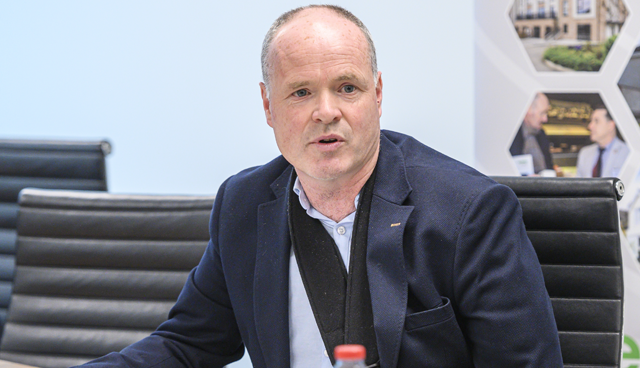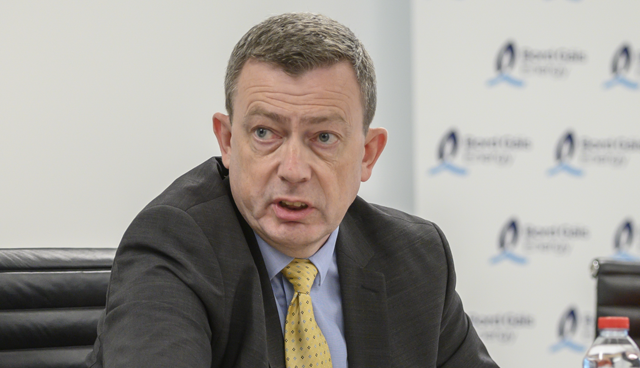
Croí Cónaithe (Cities): Unlocking apartment development potential
4th July 2022
COVER: A powerhouse of delivery
4th July 2022ROUNDTABLE DISCUSSION: Ireland’s sustainable housing future

Roundtable hosted by:
Bord Gáis Energy hosted a round table discussion on the topic of Ireland’s sustainable housing future, bringing together stakeholders from the public, private, non-profit, and academic sectors.
What are the main challenges of successfully retrofitting 500,000 homes by 2030?
Dave Kirwan
Skills and costs. 12 per cent of the workforce were in constru. ction at the time of the financial crash but today that is 6 per cent, 2 per cent less than the EU average. We need to support trades as a career path for young people and private companies like ourselves need to play a role. We are going to announce our first apprenticeship scheme in four decades in 2023 so we can bring our own expertise and upskill young people, and through our work with Focus Ireland to offer people experiencing homelessness the opportunity to trade up and skill up. In terms of cost, the principle of a just transition is at the core of our ambitions and government has rightly targeted social housing. The level of support for that will need to be monitored very carefully. What we cannot have is people who cannot afford to retrofit being left behind.
Ciara Ahern
Design knowledge at all levels of the value chain, level six to level 10, from designing heat pumps to thermal risk assessment is one of the major issues. How best to achieve them in sustainable housing – be it district heating or heat pumps – is across engineering and planning; it requires a huge surge in effort and knowledge. The other area is regulation and governance. We are going to be building an average of 33,000 houses per year. In a boom, there is a concern that standards might slip, and we need to keep an eye on quality throughout.
Seán Armstrong
Skills are an important pillar of the delivery, but building the supply chain, standards, the performance requirements and the systems to deliver the retrofit, is equally important. SEAI are doing a lot of good work in developing the market and supply chain and creating suppliers to support the system. The skills and the building of the supply chain need to work together with standards, and we are bringing forward the Construction Industry Register Ireland on a statutory basis to ensure this.
Ciaran Byrne
As a society we have not treated the trades well; they are more respected and valued in other countries. We will need the trades to scale up to be able to deliver on our retrofit targets. Transition and transformation are both journeys and it is critical that we do not leave people behind. We know at SEAI that the schemes we are delivering now are probably not the same schemes that we will have in 20 years’ time; we have to ensure that everybody is with us.
Pat Dennigan
Our perspective comes from tenants and people on the ground. What we need to remember is who we are doing this for: tenants in the private rented sector, approved housing bodies (AHBs), and local authorities. We have about 300,000 residencies registered with the Residential Tenancies Board, but landlords have been leaving the private rented sector and we want to make sure that the upskilling in that sector happens in conjunction with energy refitting, so the sector does not get left behind. The people coming in our door have real pressures in terms of energy costs and rent and it is important we ensure all sectors are provided for.
Bob Jordan
The main challenge is scale. 50 per cent of Irish households have a BER rating of D or lower. The Government has committed to bringing 500,000 homes to B2 by 2030 which will require deep retrofits. There are significant upfront costs, even though government grants are quite generous. It takes a while to recoup these costs through energy savings so for older people or private landlords, this is not as attractive. It would be very regrettable if some groups were left behind.
To what extent is government doing enough to encourage households, particularly low-income households, to retrofit their homes?
Ciaran Byrne
The Better Energy Warmer Homes Scheme, providing free home energy upgrades to homeowners on low incomes, is a good example of government-funded intervention. SEAI are supporting the delivery of a low-cost loan scheme which will also assist low-income households, and the National Retrofit Scheme launched in February 2022 provides for up to 50 per cent grants for home energy upgrades. One action for the immediate term was an 80 per cent grant for wall and cavity insulation, both measures which provide tangible benefits for homeowners. However, there is a concern about the rising levels of the working poor, especially as energy costs rise, and so we need to assess where the take up of various schemes is happening and what policy levers need to be adjusted to ensure a just transition.
“12 per cent of the workforce were in construction at the time of the crash but today that is 6 per cent, 2 per cent less than the EU average. We need to support trades as a career path for young people and private companies like ourselves need to play a role.” Dave Kirwan
Pat Dennigan
The objectives contained in Housing for All are very welcome and energy efficiency is a priority for us all. How we manage these priorities as a nation is important. We have concerns around how AHBs can avail of these schemes and how we can do it in an efficient and cost-effective manner. We have delivered retrofitting in a limited way ourselves and the benefits to individual households and the community is clear, but it has to be attractive for the AHB sector and also the private rental sector, where we hear one in five landlords are planning to leave the sector in the next five years.
Bob Jordan
It’s crucial that social housing tenants benefit from retrofitting. Almost 40,000 of the 500,000 homes to be retrofitted under Housing for All will be local authority homes. This year the Government has set aside €85 million for energy upgrades to about 2,400 homes, which is important. Also of note is that AHBs can benefit from the new National Home Energy Upgrade Scheme, providing grants to bring homes up to an energy efficiency rating of B2 or above.
“The regeneration of town centres has massive potential, and we must make sure that it happens, and that can dovetail with energy efficiency and create a wider environment for people to live in our town and city centres.” Pat Dennigan
Seán Armstrong
Alongside the Housing for All commitment of 500,000 retrofits by 2030, the sectoral emission ceilings outlined in the Climate Action Plan have a built environment pillar, encapsulating in law the necessary targets and aligning with the Energy Performance of Buildings Directive at European level. The added benefits of improved health and comfort should also be taken into account when improving the energy performance of dwellings. It is important that the implementation of these measures is managed so as not to impact negatively on housing supply, in particular rental properties. That is why the Department is proposing to commence a study to measure the impact of these policies before the end of 2022.
Ciara Ahern
The Better Energy Warmer Homes Scheme, while very welcome, is primarily a fabric first approach and we need to focus on heating system upgrades. Modelling we have carried out in TU Dublin indicates that a lot of cavity walls have been filled and that market is becoming saturated. This is a good example of policy lagging the renovation wave because we do not have data tracking the housing sector. In recent years we founded the Irish Building Stock Observatory to address this, coalescing researchers to deliver real-time analysis of stock, mapping transformation, and indicating hard-to-decarbonise homes to identify common characteristics which could be addressed by targeted policy.
Dave Kirwan
The Government has been ambitious and has proposed substantive mechanisms. Mindful of the fact that we’re starting to see price inflation, having percentages sometimes masks the absolute. 50 per cent 12 months ago is now in absolute terms going to cost a lot more. Neither can it only be a government challenge, private companies need to play their part through financing solutions to get people to retrofit. We intend to launch prepayment plans in 2023, and they will have to accompany expertise and skills to get the widest possible cohort of householders to retrofit.
“There is a concern about the rising levels of the working poor, especially as energy costs rise, and so we need to assess where the take up of various schemes is happening and what policy levers need to be adjusted to ensure a just transition.” Ciaran Byrne
How can an average of 33,000 new homes be constructed in an environmentally sustainable way each year?
Seán Armstrong
We are building to nearly zero energy rated levels, typically an A2 rated home. Heating systems in 80 per cent of new homes are from renewables. The draft Energy Performance of Buildings Directive contains a proposal that all new homes from 2030 have a declaration of the global warming potential of the materials in the home. To have that in place, materials need to be certified under the Construction Products Regulation, which is under the review at the moment. Calculation methodology also needs to be put in place to calculate the global warming potential of these materials. Emissions from construction materials make up 10 per cent of emissions worldwide so it’s important to achieve this change.
Bob Jordan
Housing for All aligns with the National Planning Framework, which commits to compact urban growth, so 50 per cent of new homes built will be in the existing footprints of our cities, which is an important commitment for sustainability. We have about 70-80,000 planning permissions that are non-activated. The Government’s Croí Cónaithe Cities fund is about ensuring that up to 5,000 apartments are provided for home purchasers in our urban centres, bridging the viability gap between apartment delivery costs and market prices. Apartment living means people being closer to employment, social activities, and transport in support of the 15-minute city idea. The recovery of vacant properties in towns and villages under the Town Centre First policy will increase the supply of social housing for specific groups, including older people and people who are homeless, as well as improving streetscapes and generating carbon savings.
Dave Kirwan
There are quality and quantity challenges here. The cumulative effect of delays in getting legitimate housing developments through the planning system over a 10-year period could have a serious impact on achieving our objectives. Currently, there are 24,000 homes delayed by challenges, 8,700 homes will not be built and 11,700 are at risk in the current cohort of houses; this is not unique to housing, the challenges to offshore and onshore wind are well known. This is a generational challenge that needs to be addressed. The systematic cost of the delays are building and exacerbating the challenge we face.
“It is important that the implementation of these measures is managed so as not to impact negatively on housing supply, in particular rental properties. That is why the Department is proposing to commence a study to measure the impact of these policies before the end of 2022.” Seán Armstrong
“If we are going to realise heat savings we must connect housing to district heating systems… Our local authorities are going to be helped with the purchase of land and there’s €4 billion for water infrastructure but no mention of district heating; that’s something we need to solve.” Ciara Ahern
Ciara Ahern
47 per cent of the cost of building an apartment is in labour, materials, and productivity. The standardisation of future local authority dwellings is welcome in that regard because it will give the industry certainty and allow it to adapt for modern methods of construction. Looking at the standardised homes, I’m disappointed to see boilers still there; between 2017 and 2020 we linked 40,000 homes to the gas network; that is a problem future generations are going to have to undo. If we are going to realise heat savings we must connect housing to district heating systems. 66 per cent of Sweden’s heat is from renewable energy and district heating. Our local authorities are going to be helped with the purchase of land and there’s €4 billion for water infrastructure but no mention of district heating; that’s something we need to solve.
Dave Kirwan
The ban on the installation of gas boilers in 2025 is a reality and is appropriate. The challenge is to give householders a desirable alternative. We will have alternatives for customers, but the homes need to be fit and ready for heat pump technology.
Ciaran Byrne
We are at tipping point by any metric. We need to accelerate on district heating, it’s not a new technology by any means. Obviously, it has improved over the years, but it has been around for a long time, and we need to get on with it and delivery it in appropriate locations. I’m glad to hear that Bord Gáis are looking at heat pumps because we also need to accelerate alternate choices.
Pat Dennigan
The regeneration of town centres is important; it can make a massive difference from the point of view of energy and bringing life back into our towns and cities. The other aspect that has a lot of potential is modular housing and the construction of housing off-site. The construction phase is a carbon-heavy process and construction off-site has massive potential and could be used both for speed and carbon efficiency.
What role will innovation in the construction industry play in improving sustainability in the housing sector?
Seán Armstrong
Section 5.3 of Housing for All commits to innovation in the housing sector, to modern methods of construction through a whole-of-government approach. Enterprise Ireland are establishing a construction technology centre which will support and promote innovation in the construction sector and prioritise residential construction. There are also plans being developed for a demonstration park for modern methods of construction and separately there is a residential construction cost study being carried out. This links with sustainability through the low-emitting materials and lesser waste of modern construction and that is a key part of Housing for All.
Ciara Ahern
The construction technology centre is massively welcomed by the research community. It will allow modern methods of construction to be tested and hence realised and allow contractors to try out new methods before investing. It is a total change from Enterprise Ireland’s usual remit, which is internationalisation, which is a fantastic reaction to the crisis.
“The most sustainable approach to ending homelessness is a housing-led one, where people are provided with permanent housing and the supports they need to live in the community.” Bob Jordan
Bob Jordan
We have a technical unit supporting the local authorities and AHBs in terms of their build programmes, looking at how to use modern methods of construction in delivering the social housing programme, and advancing the use of design and build contracts. The use of building information modelling has been the future for a long time, but its use in public sector projects is important in terms of innovation. We recently ran the Housing Unlocked initiative with the Irish Architecture Foundation looking for innovative ideas, where we received great ideas around converting churches and banks into homes, the use of modular housing, and reimagining existing neighbourhoods. The public engagement is important because that is where the demand for innovation will come from.
Ciaran Byrne
The public demand innovation and we are now linking that into tangible things. We see that with heat pumps; what we will be using in 2030 will be far better than what we are using now. People expect innovation; they want apps with real-time information. It is up to us to use technology to bring information and new ways of thinking and doing, to the public and that is a big driver going forward.
Dave Kirwan
The customer experience will have to be good. We are wrestling with what it looks like for the customer. A digital experience of installing a heat pump in a home two weeks after receipt of order with engineers on the doorstep at the same time as the equipment arrives for installation: that’s the vision. I suspect this will be replicated in other aspects of the developing sustainable housing model. It contrasts with the building of a house over nine to 10 months; shorter windows to deliver apply, and it needs to be a great customer experience, because the first 15,000 will have a huge impact on the reputation of this programme.
How does the eradication of homelessness by 2030 align with Ireland’s sustainable housing future?
Pat Dennigan
It is hugely important for us as a country to set the objective of eradicating homelessness by 2030. There is an awful lot of work involved that people familiar with the topic even underestimate. Most people who come to Focus Ireland come from the private rented sector, typically because the landlord is selling the home, which necessitates a notice of termination. We cannot allow the work being done in the retrofit process to impact that contribution over the next eight years, because one will get in the way of the other. The regeneration of town centres has massive potential, and we must make sure that it happens, and that can dovetail with energy efficiency and create a wider environment for people to live in our town and city centres. The sense of place, community, and ownership that some of our tenants have developed in areas where we have completed retrofitting is fantastic and we must build on that.
Bob Jordan
There is a danger of ‘renovictions’ whereby people are made homeless because of retrofitting processes, and we need to make sure that communities are maintained while we are doing upgrades. The most sustainable approach to ending homelessness is a housing-led one, where people are provided with permanent housing and the supports they need to live in the community. The problems created by climate change make conditions worse for people who are sleeping rough in terms of extreme weather and that means further urgency is required to end homelessness. Also, most people on social housing waiting lists and people who are homeless require one-bedroom properties, so we need to get the mix right in terms of properties to ensure we have sustainable and integrated communities.
Ciaran Byrne
‘Renovictions’ are a topic that have come up twice now in recent Oireachtas committees. It has been flagged as a concern, although it is not showing up on the ground at the present time. To renovate a home to a B2 standard, a person should not have to leave their home in all but the most extreme circumstances and often this is when additional construction works are being done at the same time. Tenants in the private rented sector have seen the usage of various levers to get tenants out, and we need to ensure that home energy upgrades do not become one of those levers.
Ciara Ahern
We need good data that we can track. The Irish Building Stock Observatory are developing a methodology for downloading data from the EPC/BER database, using machine learning and AI to process data before clustering dwellings by common characteristics. By carrying out this analysis regularly we will be able to track the state of the stock, recommending policy changes to address households that are proving hard to decarbonise or that are resistant to the renovation wave. To inform policy that addresses vulnerable households specifically we need a greater level of trust with sensitive data to appropriately inform a sustainable housing future for this cohort particularly.
Seán Armstrong
Safeguards that currently exist for tenants include that landlords are required to offer back properties to the former tenant upon completion of renovation works, where the tenant provides contact details for such an offer to be made, a notice of termination must contain or be accompanied by a written certificate of a registered professional stating that the proposed substantial works would pose a health and safety risk necessitating vacation and that such a risk would be likely to exist for at least three weeks. A once-off exemption from rent caps is permitted in respect of the first rent setting after works resulting in a substantial change in rental accommodation, as set out in the Residential Tenancies Act 2004. Housing for All commits to work with local authorities to increase the social housing programme so that an average of 9,500 new-build social homes are provided each year under Housing for All.
Dave Kirwan
We cannot achieve our net zero targets at the expense of putting up with homelessness. Insofar as there are supply and demand challenges, they cannot be allowed to exacerbate our homelessness crisis. Alleviating this crisis has got to be a performance measure and there will likely be interventions needed to maintain momentum. Looking at it optimistically, we are creating momentum around decarbonising existing housing stock and the creation of new homes, so the marginal cost of fixing homelessness might never be cheaper. If we are sitting here in 2030, and we have hit our net zero targets but there are still homeless people in Ireland, I think we can all agree that is failure.












